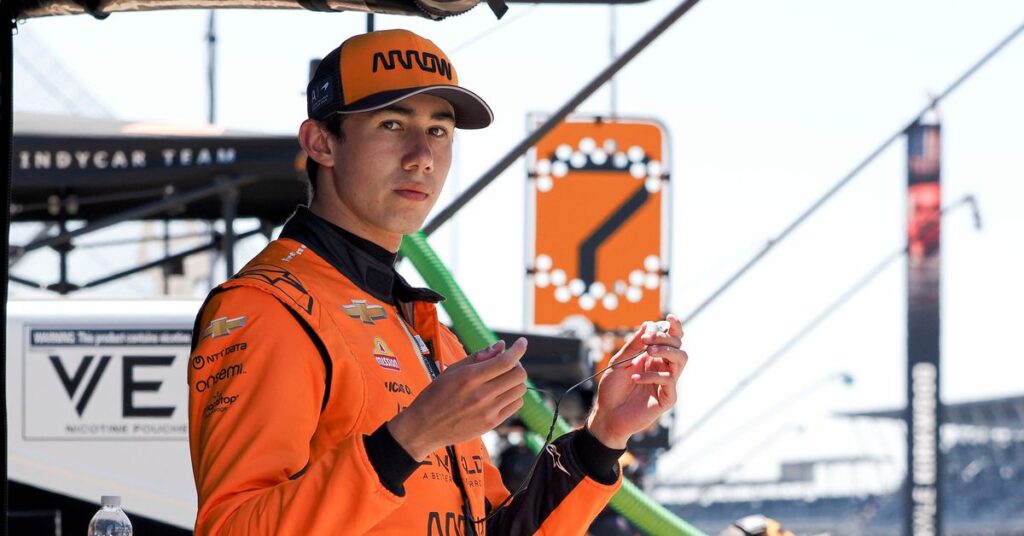On Qualifying Sunday ahead of the 2024 Indianapolis 500, as the seconds ticked down during Last Chance Qualifying, one driver was left with a shot to put their car in the show.
19-year-old Nolan Siegel.
Driving for the No. 18 for Dale Coyne Racing, Siegel had one last chance to qualify for his first Indianapolis 500. But if the moment was not tense enough, an incident from earlier in the week only heightened the tension. During the Friday practice session, Siegel spun and then went airborne in a scary crash, with his No. 18 Dale Coyne Racing Honda finally coming to a stop, flipped on the track.
Still, Siegel had a chance at glory and left everything on the track, only to crash again on his second of four push laps:
The crash knocked him out of the 2024 Indianapolis 500, but it is what Siegel said after the session that left a lasting impact on the entire paddock, as well as one sportswriter watching from home.
“I said it before and I’ll say it again, I’m not going to go home because I lifted,” Siegel said last May. “I’m going to go home because I did everything I possibly could. Ultimately, that wasn’t good enough and we went too far. So here we are.”
This month, that sportswriter had a chance to chat with Siegel ahead of the 109th Indianapolis 500, and that moment was one of the first questions I had for him.
Siegel has no “regrets” from what happened in Indianapolis a year ago.
“Yeah, there’s a huge amount that I learned last year, and as difficult as that was, I’m in a way better spot now than I would be having not done that.
“So definitely no regrets on that front.”
As far as what Siegel learned from that incident, the young Arrow McLaren driver told me that his biggest takeaway involves the mental approach an IndyCar driver needs during the sport’s biggest month.
“But, I think the biggest thing I learned is just kind of the mindset that you need through the month of May, and having the experience of not just driving a race car, but the whole experience of the month and all of the things off-track that you have to do, and it’s so different from any other race weekend,” added Siegel.
“It’s pretty chaotic, and being able to manage all of that, I think, is a big part of it, and being able to stay in the right headspace is a big part of it, and I was lucky to have great people supporting me.
“Charlie Kimball was on the radio and kind of my Indy 500 mentor, if you will.
So I learned a lot from him on just kind of how to handle different situations there, and I feel like through the month, I got to experience many years’ worth of different situations at the Speedway.
They were difficult, but I think, even if you’re having a great month, there are gonna be difficult times in the month of May and and being able to stay in the right headspace through all of that is really important, so I think that’s the biggest thing I learned.”
Now Siegel will get his chance to put those lessons into action during his first Indianapolis 500.
The start to the 2025 season for Nolan Siegel
Siegel was a part-time IndyCar driver during 2024, with commitments pulling him in multiple directions. Shuffling between commitments with Dale Coyne Racing for IndyCar, driving for United Autosports at the 24 Hours of Le Mans, the year got off to a frenetic start.
But in June, Siegel was named as a replacement for Théo Pourchaire at Arrow McLaren and drove in the final ten races for the team during the IndyCar season. Siegel managed one finish in the points during that stretch, with a P7 at the Bommarito Automotive Group 500 in Madison, Illinois.
Siegel was signed by Arrow McLaren to a “multi-year” deal, which includes the 2025 IndyCar season.
Our conversation began with a discussion of his 2025 campaign to date, which includes one finish in the points, a P9 at the Children’s of Alabama Indy Grand Prix at Barber.
“We’ve had our ups and downs already.
‘I know it hasn’t been very long. I feel like we’ve been off to a good start,” began Siegel.
“Actually, the No. 6 car group changed pretty much completely in the offseason, so St. Pete was really our first chance to work together on a race weekend, and I think that we had a lot of pace there. Had some bad luck in the race, and didn’t really get to show it.
“Thermal was a rough weekend.
‘Long Beach, similar deal, we had tons of pace. I think we could have transferred to the Fast Six, and then I got food poisoning, got sick, and we had just a kind of race [that] didn’t go our way.”
Things came together for Siegel and the No. 6 team in Barber.
“Finally I think in Barber it kind of played into our hand a little bit more, and I think as we go through the season and if we can continue to perform the way that we’ve been performing, then there will be a little bit of luck, and I think that we’ll be fighting for podiums later on.
“So I’m very happy with where we’re at right now.”
Still, Siegel called the finish at Barber a bit “bittersweet,” given where he qualified.
“It was a little bit bittersweet actually,” said Siegel when asked about the P9 in Alabama.
“Having qualified sixth, that was my first Fast Six, that was our best qualifying. We were excited about that and our hope was to be fighting in the top 5, and I think that realistically we could have been.”
However, the young driver noted that a few “small mistakes” pushed them a bit further down the grid. Still, to be disappointed over a Top 10 tells Siegel just how much progress he and the No. 6 team have made.
“There were just a couple like really small mistakes that happened through the race and it put us a little further back than we wanted to be. I feel like it shows how much progress we’ve made that everyone is slightly disappointed with ninth, because ultimately that is a good result, and in IndyCar results like that are difficult,” described Siegel.
“I mean, you look at the field and. there are plenty of championship contenders that are outside the top 10 pretty often. It’s just a competitive series, and I think that it shows a lot of promise that we’re disappointed with, with where we were in Barber.
“So I think if everything goes right, I think we’re going to be fighting in the Top Five.”
The biggest adjustment for Siegel moving to the grid full-time?
Moving to Indianapolis.
Still, that has given the young driver from Northern California a chance to be with the team full-time, which has given him another edge.
“Last year doing the couple of races, you know, I went to the shop once, maybe twice, before the [Indianapolis] 500 and really, I didn’t see any of the people I was working with unless we were at the racetrack,” said Siegel.
“And that’s absolutely not the case now. Now I spend a ton of time with everyone away from the track. I spend a ton of time with the team at the shop. I’m there almost every day, and it just, I’m always in it, and it makes a big difference when you don’t take these breaks and then have to kind of like rebuild when you get back to the track.
“Now, we’re all together all the time, always working on IndyCar, and that makes it a lot easier for me.”
The Month of May in IndyCar
Ask anyone associated with IndyCar about the “Month of May,” and their eyes light up instantly.
Siegel is no different.
The month begins with the race in Barber, and then the Sonsio Grand Prix, which is held on the road course at the Indianapolis Motor Speedway, building to the huge spectacle that is the Indianapolis 500.
I asked Siegel to put into words what makes the Month of May so special.
It starts with the sport’s rich history.
“Everyone knows how much it means, and I think part of it’s the history,” began Siegel.
“You look at the list of Indy 500 winners and everyone wants to have their name on that list with everyone else that’s on that list, but I think another part of it is [that] almost all of us live in Indianapolis now.
“It’s really the home of IndyCar, and it’s just so big for this city, and everyone gets so excited about it, and the feel of the whole city in May just completely changes,” added Siegel.
“And seeing that, for a lot of us that have moved from other places and now kind of call this home to see that the city fully embraces IndyCar and how excited everyone in the area is for it to be May is just pretty special, and it’s cool to be a part of something that brings so many people together and the whole city gets so excited about.”
Something else that is special?
Turning a lap at Indianapolis Motor Speedway, which is a feeling Siegel described to me as “unlike any other feeling” in a race car.
“It’s, it’s pretty special,” began Siegel when I asked him about what a lap at IMS is like.
“It’s unlike any, any other feeling I’ve had in a race car, for sure. I think at that speed and at the speedway as well, it’s so sensitive and you have to be so precise,” continued Siegel. “It’s very fast, but at the same time,all the details matter so much, so you’re paying attention to such small details. I feel like you don’t really get a sense of the speed so much because you’re paying attention to such, such fine details.”
Those finer details make the experience of a lap at Indianapolis Motor Speedway unlike anything else in the sport.
“So it’s just very, very precise and it’s something that requires a different level of precision and attention to detail than any other track and any anything I’ve ever done in any other race car.”
Driving at Indianapolis Motor Speedway
While turning a lap at the Indianapolis Motor Speedway may be special, there is something the experience is not.
Easy.
The massive 2.5-mile oval may look simple on paper, with each turn the same and two long straights, but every turn and every lap are different.
Sometimes very different.
“It’s funny cause every corner is geometrically the same. It is, they are identical,” began the Arrow McLaren driver.
But there is a big difference between geometric similarities, and what those corners feel like at 240 miles per hours per hour.
“They feel completely different to drive,” continued Siegel.
“It’s visually different in Turn One, you have the grandstand in Turn Three, you have a smaller grandstand, it’s much more open, it looks different, which just changes your references.
“And again, when you have to be that precise, it makes a bigger difference than you would think just having a different visual,” Siegel added.
“Again, the grandstand blocks wind, and the wind is huge at the speedway.”
For comparison, Siegel drew a line between an IndyCar and an airplane.
“I think of the car kind of like an airplane to a certain extent. We’re going that speed, and the wind affects it massively.”
Which means that in addition to everything else they are doing inside the cockpit throughout a lap, drivers have an eye on the windsock atop the scoring pylon.
All while rocketing around IMS at speeds over 240 miles per hour.
“So you’re always looking at the windsock, and that can make the different ends of the track feel really different as well.”
“So if you have a big headwind into Turn One and a big tailwind into Turn Three, the balance of the car is completely different and you have to be on top of the tools to change the weight jacket, change the roll bars preemptively, to make sure that you have the right balance in the corner based on the wind and what you’re seeing on the wind sock,” described Siegel.
“It is interesting that they all should be the same, but yeah, they’re nowhere close to the same.
“You have little bumps and things, they look different, and with the conditions being different and the wind changing constantly, it’s never the same.”
Nolan Siegel’s expectations for the 109th Indianapolis 500
As our time drew to a close, I wanted to focus more on Siegel’s expectations for the Indianapolis 500, starting with his thoughts on the special paint schemes Arrow McLaren is rolling out this week.
Siegel noted the team’s “Never Stop Racing” campaign, which he believes brings the entire McLaren operation together, from the Formula 1 side of the operation to the IndyCar side, and more.
“I think they look amazing,” began Siegel when I asked about the liveries.
“I think it’s really cool to have a McLaren-wide campaign as well, with the ‘Never Stop Racing’ campaign.
“So it’s cool for us. The cars look great, but it’s also cool to have that connection to the Formula One team and just have that connection to the rest of the McLaren organization, so I think it’s awesome.”
The young Arrow McLaren has also begun to dream of what it will be like to roll that car off the line for his first Indianapolis 500.
“I’ve been thinking about that too, it’s gonna be pretty special,” said Siegel when I asked him how that moment will feel.
“I was on the grid last year, and that was the first time I’d stood on the grid, and even not racing [being on the grid] was pretty amazing.
“There’s nothing like seeing a grandstand packed full, going for a mile.
“So, it’s going to be a surreal experience, and it’s something that I’ve been waiting for for a long, long time. So really, really excited.”
As for his expectations heading into his first Indianapolis 500, which will see him start 26th, Siegel told me when we spoke ahead of qualifying that he had “big expectations” for the 500.
“We have big expectations, The car has been really fast the last few years, so I think we’re in a good spot.
“The team [has] worked really, really hard on the speedway cars, and they are really, really well-built and really nice this year,” began Siegel.
“For the race, as a rookie, I think part of it’s a little bit survival,” continued the young driver. “But no, it’s hard to know right now before we go because everything changes so much.
“Yes, we had the test, but you don’t really know where everyone’s gonna stack up.
“I think we’re gonna be really competitive, and I think that if we end up qualifying really well, then the goal is gonna be to win the race.
“If we end up struggling more in qualifying, maybe the goal is to stay clean and finish in the Top 10,” added Siegel. “But, I am hopeful that we will be in a position to show up on Sunday and feel like we actually have a shot at running up front.”
Siegel is in the show for the first time this year, and he will get that chance to try and run up front in the 109th Indianapolis 500 next Sunday.
]



